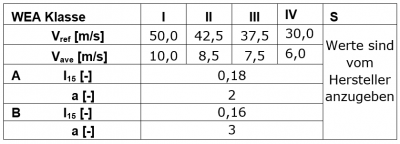Lasten - Anhang VI: IEC 61400-1 ed.2 (1999)
Zur deutschen Hauptseite | Alle deutschsprachigen Seiten
Deutsche Übersetzung folgt.
From windPRO version 3.1, SITE COMPLIANCE supports the second edition of IEC 61400-1 (IEC ed. 2), which was released in 1999[1]. The second edition was replaced by the third edition in 2005, which was updated in 2010 (IEC ed. 3). Hence, IEC ed. 2 is, in principle, obsolete, but, nevertheless, it continues to be used by conservative turbine manufacturers or when new park extensions influence existing ed. 2 turbines, and they need to be assessed for, e.g., life reduction due to increased wake turbulence. The general IEC ed. 2 requirements for assessment of a wind turbine using site-specific conditions is defined in section 11.2 of the standard in the part inserted below.
For many of the wind climate requirements in IEC ed. 2, no explicit or direct calculation guideline is given. The below text summarizes the decisions made for calculation and evaluation of the IEC ed. 2 checks – the governing principle has been to re-use as much as possible from the current IEC ed. 3 version.
Terrain complexity
There is no explicit description of how to assess terrain complexity in IEC ed. 2, only that it is required. We have decided to fully adopt the terrain complexity calculations of IEC ed. 3, to fulfill the IEC ed. 2 requirements.
Extreme wind
The design value and, hence, upper limit of the 50 year extreme wind is Vref for the design class in question as in IEC ed. 3.
Wind distribution
There is no specific limits or check ranges defined for wind distribution in IEC ed. 2. Since the design climate is defined by mean wind speed for the wind turbine class and k=2, these values are used as the check limits. (see Appendix III - Critical, Caution & OK limits in SITE COMPLIANCE).
(Effective) Turbulence
The IEC ed. 3 Effective turbulence calculation to combine ambient and wake turbulence has been adopted to fulfill the IEC ed. 2 requirements. However, it is with the important difference that the 84th percentile of the ambient turbulence is used for IEC ed. 2 as opposed to the 90th in the IEC ed. 3. The IEC ed. 2 standard only requires the check performed at 15 m/s with a design value and, hence, upper limit of I15 for the relevant design class.
Wind shear
The design value and upper limit of wind shear is set to 0.2 in IEC ed. 2. We have chosen to supplement this by the additional lower limit at 0.0 defined in IEC ed.3, as very low wind shears are equally damaging as high wind shears.
Flow inclination
The upper and lower limits of flow inclination are defined as +/-8° from horizontal as in the IEC ed. 3.
Air density
A design air density and, hence, upper limit of 1.225 kg/m3 is defined in IEC ed. 2, as in IEC ed. 3.
- ↑ IEC 61400-1 ed. 2, 1999, Wind turbine generator systems – Part 1: Safety requirements
